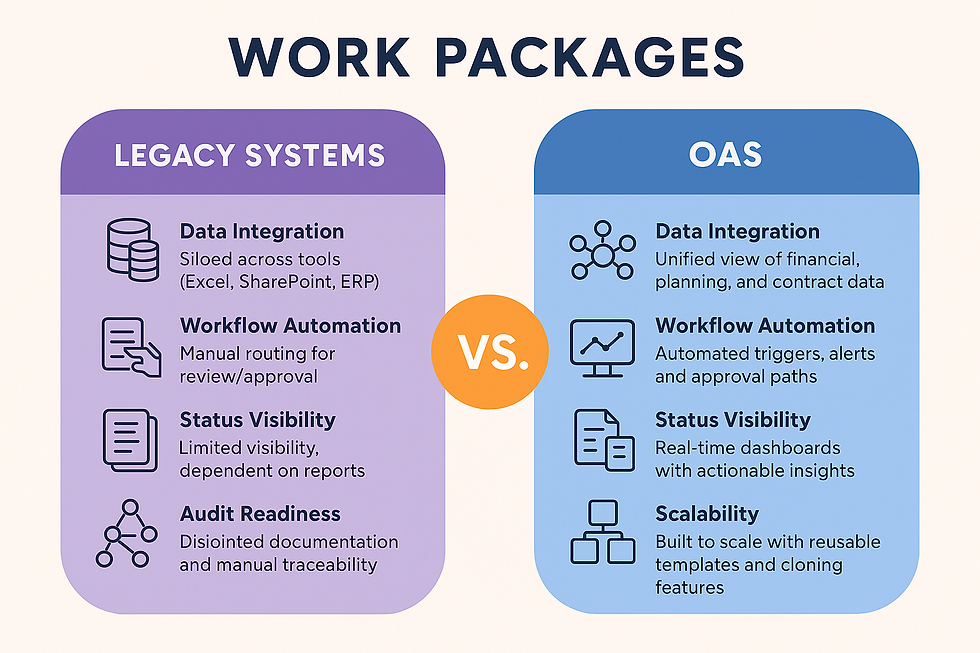Work Package Insight
- nGAP Inc
- Jul 28
- 2 min read

In the complex world of government contracting and acquisition, work packages are the foundational building blocks that transform strategy into action. These packages, which define specific scopes of work, timelines, resources, and deliverables, are essential for managing everything from multi-year defense projects to IT system rollouts. But in legacy acquisition systems, managing work packages often means wrestling with siloed data, fragmented workflows, and time-consuming approvals.
nGAP’s Open Acquisition System (OAS) is designed from the ground up to streamline and modernize every aspect of acquisition management—including work packages. Unlike legacy systems that treat work packages as static documents buried deep in spreadsheets or disconnected procurement tools, OAS embeds them within a dynamic, interconnected digital ecosystem.
What Is a Work Package within OAS?

In OAS, a work package is a modular, trackable unit of effort that links planning, funding, contracting, and performance data across the acquisition lifecycle. It acts as the connective tissue between a project’s objectives and the execution strategy—assigning responsibility, mapping resource allocations, and triggering workflows for contracting and financial tracking.
Each work package in OAS includes:
Scope definition with clear deliverables and objectives
Funding source linkage with real-time budget integration
Milestone tracking and automated alerts
Contracting task generation including draft solicitation and task order support
Status dashboards for monitoring execution and compliance
How OAS Improves on Legacy Systems
Legacy systems—often patchworks of disconnected platforms—treat work packages as static inputs to broader contracting tasks. This results in:
Duplicated effort across budgeting, planning, and contracting systems
Delayed decision-making due to poor visibility
Manual reconciliation of financial and performance data
High overhead for approvals and audits
OAS redefines this process with a fully integrated and transparent approach.
Feature | Legacy Systems | OAS |
Data Integration | Siloed across tools (Excel, SharePoint, ERP) | Unified view of financial, planning, and contract data |
Workflow Automation | Manual routing for review/approval | Automated triggers, alerts, and approval paths |
Status Visibility | Limited visibility, dependent on reports | Real-time dashboards with actionable insights |
Audit Readiness | Disjointed documentation and manual traceability | Built-in audit trails and compliance tagging |
Scalability | Difficult to adapt for multi-program portfolios | Built to scale with reusable templates and cloning features |
Better Collaboration and Governance
OAS promotes collaboration between program managers, contracting officers, and financial analysts by assigning tailored roles to each user within a work package. Everyone sees what they need—no more, no less—ensuring clear accountability and security without bottlenecks.
Built-in validation logic helps avoid common errors that plague legacy processes, such as incomplete funding information or misaligned deliverables. This reduces rework and accelerates timelines without compromising compliance.
Modularity That Drives Agility
Work packages in OAS are designed to be modular and reusable. Users can create templates for recurring projects, clone previous efforts, or split packages as priorities shift. This agility is a game-changer for agencies managing dynamic portfolios with overlapping funding cycles and evolving missions.
Smarter Acquisition Begins with Smarter Work Packages
With OAS, work packages are no longer static paperwork—they are living assets that drive execution, visibility, and accountability. By eliminating fragmentation and infusing automation into the acquisition lifecycle, OAS empowers agencies to spend smarter, deliver faster, and stay audit-ready by design.